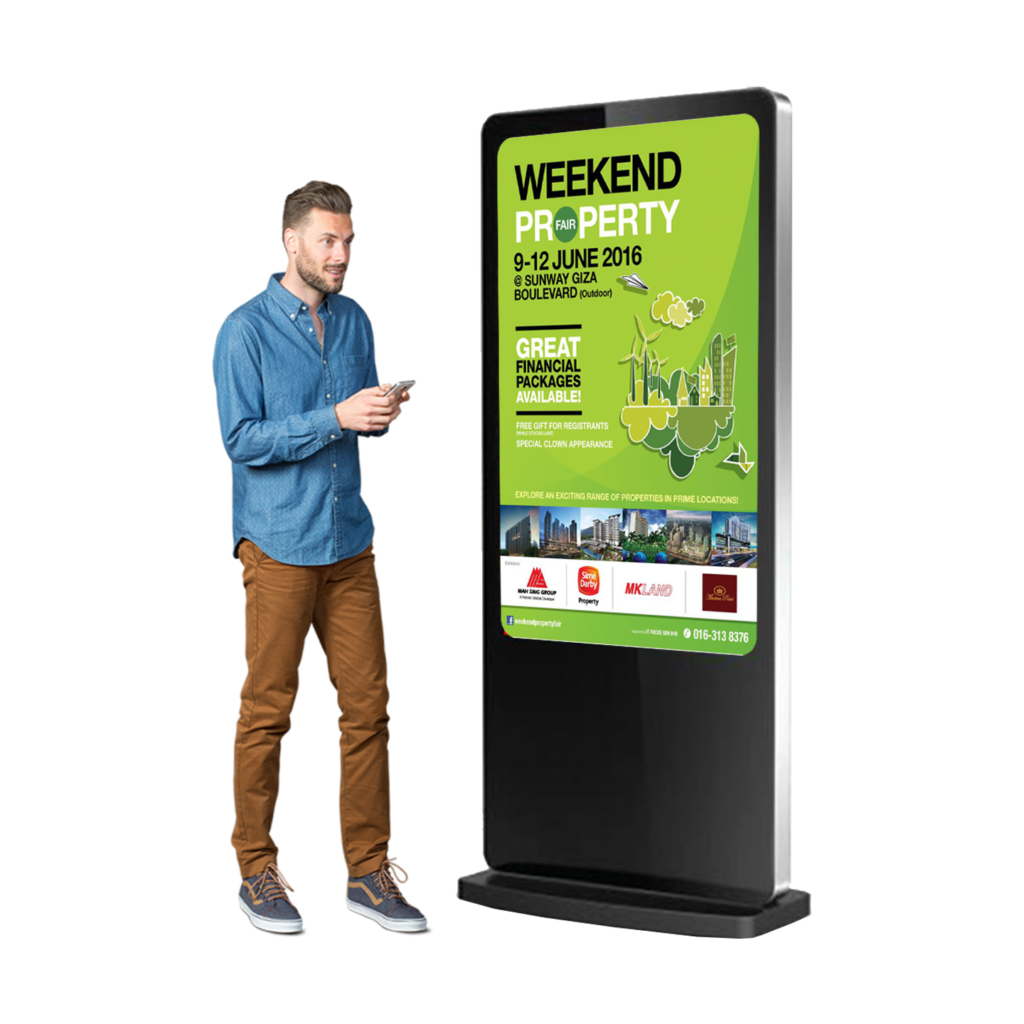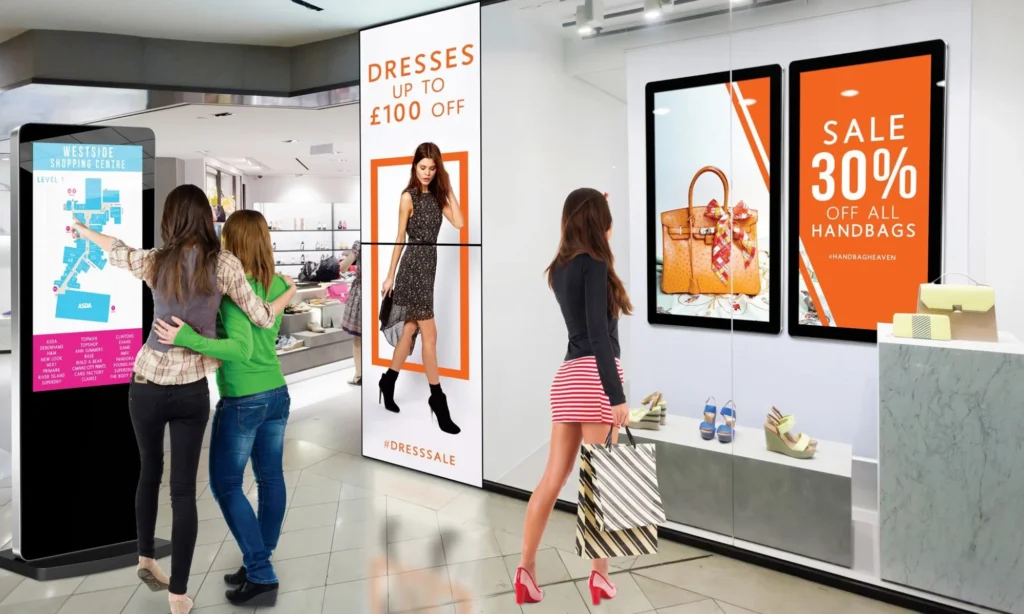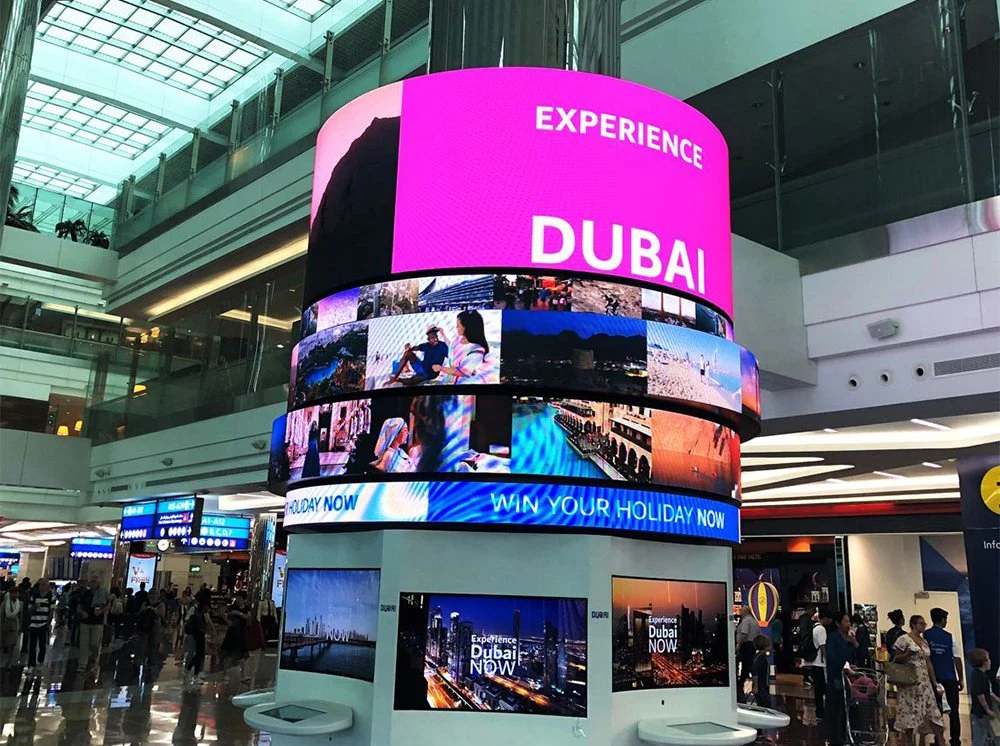Digital Signage Standee And Kiosk Machine?
Digital signage standee and kiosk is a segment of electronic signage. Digital displays use technologies such as LCD, LED, and projection to display digital images, video, web pages, weather data, restaurant menus, or text. They can be found in public spaces, transportation systems, museums, stadiums, retail stores, hotels, restaurants and corporate buildings etc., to provide wayfinding, exhibitions, marketing and outdoor advertising. They are used as a network of electronic displays that are centrally managed and individually addressable for the display of text, animated or video messages for advertising, information, entertainment and merchandising to targeted audiences.


Digital signage standee and kiosk Technology Interactivity
Interactive digital signage allows end users to interact with digital content via touchscreens, body sensors or QR codes via smartphones.
Digital signs can interact with mobile phones using SMS messaging and Bluetooth. SMS can be used to post messages on the displays, while Bluetooth allows users to interact directly with what they see on screen. In addition to mobile interactivity, networks are also using technology that integrates social and location-based media interactivity. This technology enables end users to upload photos and messages to social networks as well as text messages.
The widespread use of smartphones led to the development of screen–smart device interaction technologies. These allow smartphone users to interact directly with the digital signage screen, for example, participate in a poll, play a game, or share social network content. JPEG images and MPEG4 videos remain the dominant digital content formats for the digital signage industry. For interactive content, HTML5 and Unity3D are widely used due to their popularity among web developers and multimedia designers.
Context-aware digital signage standee and kiosk
Context-aware digital signage leverages technologies such as sensors, cameras, beacons, RFID technologies, software programs and network connectivity including the Internet of Things (IoT) to monitor the ambient environment, process information and deliver promotional messages based on environmental cues.] Many digital signage products include cameras and gather shopper demographic data by estimating the age, gender and economic status of passers-by and use this information to update signage as well as to provide back-end analytics and shopper profiles.
Equipment and network infrastructure
Digital signs rely on a variety of hardware to deliver the content. The components of a typical digital sign installation include one or more display screens, one or more media players, and a content management server.
Sometimes two or more of these components are present in a single device but typically there is a display screen, a media player, and a content management server that is connected to the media player over a network. One content management server may support multiple media players and one media player may support multiple screens. Stand-alone digital sign devices combine all three functions in one device and no network connection is needed. Digital signage media players run on a variety of operating systems including Windows, Linux, Android and iOS.
Some digital signage with the ability to offer interactive media content will come with a usage reporting function. Each interaction users have made with the digital signage such as the photos that were taken, the number of games that were played will be recorded in the digital signage and produced in the form of a usage report. From the report, owners of the digital signage will be able to gauge the effectiveness of the particular advertisement or media content that was in play at the specific hour based on the number of times interaction has been made.

Digital signage standee and kiosk Role:
The many different uses of Digital signage standee and kiosk allow a business to accomplish a variety of goals. Some of the most common applications include:
Public information– news, weather, traffic and local (location specific) information, such as building directory with a map, fire exits and traveler information.
Internal information– corporate messages, such as health & safety items, news and so forth.
Product information– pricing, photos, raw materials or ingredients, suggested applications and other product information – especially useful in food marketing where signage may include nutritional facts or suggested uses or recipes.
Information to enhance the customer service experience– interpretive signage in museums, galleries, zoos, parks and gardens, exhibitions, tourist and cultural attractions.
Advertising and Promotion– promoting products or services, may be related to the location of the sign or using the screen’s audience reach for general advertising.
Brand building– in-store digital sign to promote the brand and build a brand identity.
Influencing customer behavior– navigation, directing customers to different areas, increasing the “dwell time” on the store premises and a wide range of other uses in service of such influence.
Influencing product or brand decision-making– Signage at the point of sale designed to influence choice e.g. Signage to help shoppers to choose dresses inside a fashion store or devices that on a computerized shopping trolley helping the customer locate products, check prices, access product information and manage shopping lists.
Enhancing customer experience– applications include the reduction of perceived wait time in the waiting areas of restaurants and other retail operations, bank queues, and similar circumstances, as well as demonstrations, such as those of recipes in food stores, among other examples.
Navigation– with interactive screens (in the floor, for example, as with “informational footsteps” found in some tourist attractions, museums and the like) or with other means of “dynamic wayfinding”.
Reservations– small, interactive screens on walls or desks that allow employees to reserve the space for a limited time and integrate with a room and resource scheduling platform.
Benefits of Digital Signage Standee and Kiosk Machine
Enhance brand image
Impress your customers with a modern and sophisticated image that digital signage standee and kiosk machines can provide.
Gather customer data
With the ability to integrate with mobile devices, digital signage standee and kiosk machines can gather valuable data to help improve marketing strategies and customer experiences.
Cost-effective
Digital signage standee and kiosk machines can help reduce printing costs for traditional signage and can pay for themselves quickly.
Increased sales
By showcasing your products or services in beautiful and engaging ways, digital signage standee and kiosk machines can lead to a boost in sales.


